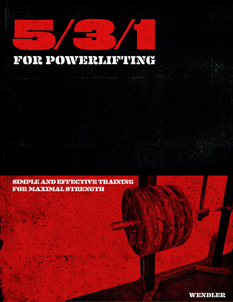

I'm lazy. I'm also a real computer geek. When I decided to try Jim Wendler's 5/3/1 program, the first thing I thought of was how to write the scripts for this webpage so I didn't have to sit down with a calculator and figure out all my lifting weights.
In 5/3/1, Wendler suggests using Excel; however, I haven't used a spreadsheet since I was in college some twenty years ago. Hence, it was easier for me to write the Javascript and PHP code for this page than to learn how to use Excel.
During the deload week of my second cycle using the 5/3/1 program, I bought 5/3/1 For Powerlifting. The only change I made to the calculator after reading this newer book was adding the "Powerlifting" option to it. (You'll have to calculate what to lift when you get closer to a meet yourself.)
I'm not going to tell you how to use this page. If you've read either one of Wendler's books, you should be able to figure it out. If you don't want to buy the books, a couple of good articles that might give you a clue as to what to do are on T Nation and the Swole. However, I highly recommend buying one of Wendler's books as they have a lot of really good information in addition to the number of sets and reps, especially 5/3/1 For Powerlifting.
If you're planning on competing, get 5/3/1 For Powerlifting and possibly the 2nd Edition of 5/3/1. 5/3/1 For Powerlifting has most of the important stuff that's in 5/3/1. The only thing that doesn't explicitly get explained is "Boring But Big," but it doesn't take a computer engineer to figure this out by simply clicking on the check box in my calculator.
If you're not planning on competing, just get the 2nd Edition of 5/3/1. (If you play football, you may want to get 5/3/1 for Football. I don't play football, so I'm not going to buy it. Thus, I can't comment on it.)
When you've calculated four waves, hit the "Download Program PDF" button and print the PDF that gets downloaded. Don't delete this PDF, but save it in a safe place on your hard drive. When you're ready to recalculate your next four waves, click on the blue text at the top of this PDF, and you will be taken back to the calculator with all your previous settings.
Don't leave the "Lifter's Name" field blank. This is how you can tell your PDF from someone else's PDF. As well, the date in the bottom right of the PDF is the date that you made some changes to your lifting weights and hit "Calculate Four Waves." If you don't make any changes to at least one of the weights, the date doesn't get changed.
The date and name also make up the filename of the PDFs, so when you store them in a folder on your hard drive, they're sorted by the name of the lifter and by the date. If the contents of your folder is listed in alphabetical order, the most recent program will be at the bottom. This would be useful if you're keeping the records of a number of lifters (e.g. a strength coach for a football team that has everyone doing 5/3/1).
Once you've completed Wave 3, enter your reps for your "all out" sets and your calculated 1RMs will be displayed (you can also change the weight for these sets). The calculated 1RMs don't appear until you enter your reps for at least one set. You can hit the "Download Calculated 1RMs PDF" button to download a PDF of these calculated 1RMs. You can print this PDF over top of the printout of your four waves. Your calculated 1RMs will be printed in the space below Wave 3 and to the right of Wave 4 (the deload wave). Once you've printed the 1RMs PDF, you can delete it.
Remember to add the weight of your collars to the bar weight if they are of any significance.
Here is an example of the printouts:
The PDF output for this calculator was built with the TCPDF FLOSS PHP class for generating PDF documents.